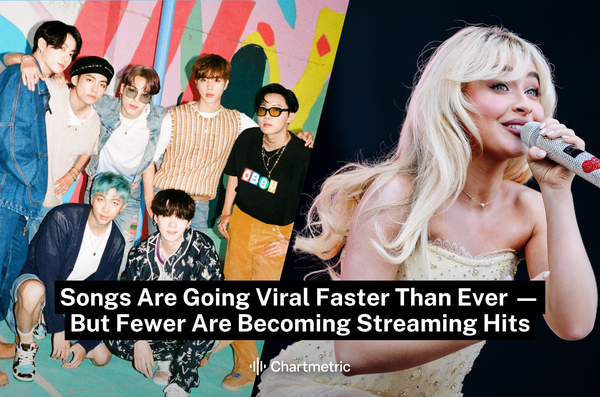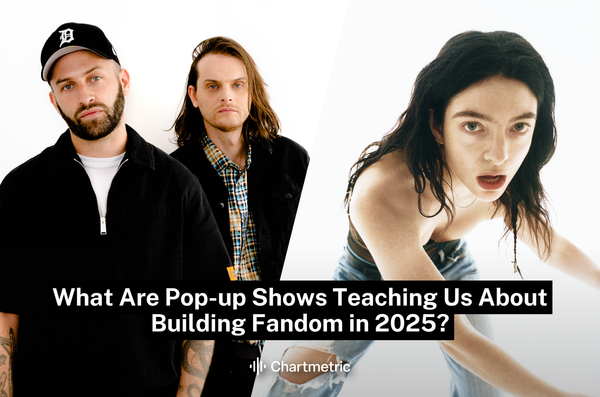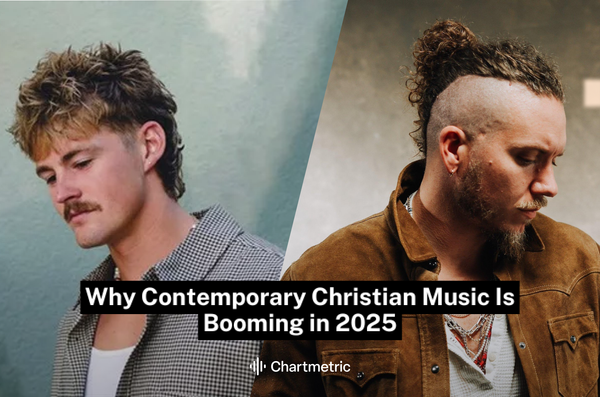When Sabrina Carpenter released “Manchild,” she followed the same formula most pop stars use today: tease the song, release it, and then build momentum on TikTok. In the weeks that followed the release, she promoted the song with a series of videos from backstage at Primavera Sound, ‘meme-fied’ soundbites, and appeared in a sponsored ad for Prada. Two weeks later, the “Manchild” had over 105k TikTok posts.
@sabrinacarpenter ♬ Manchild - Sabrina Carpenter
Whether it’s BTS’ “Dynamite” in 2020 or Justin Bieber’s “DAISIES” in 2025, it’s hard to ignore how easily certain songs dominate TikTok and, in turn, shape the sound of pop in any given year. Some songs blow up before we’ve even had the chance to hear them, while others linger on our feeds long enough to wear us out. But with the constant flood of viral hits dominating TikTok each week, it’s easy to lose track. In a landscape that moves this quickly, it’s fair to ask: are songs going viral faster than ever?
How Long Does it Take to Go Viral?
To find out whether songs are going viral faster, this analysis measured how long it took for tracks to reach a major benchmark of online traction. It examined 49 songs released each year between 2020 and 2025 that surpassed 100k TikTok posts, ranking them by total Spotify streams to ensure comparability across popularity levels. For each year, the average number of days it took to hit that 100k-post milestone was calculated. (For further methodology, see our data notes section at the end of the article.)
Over the past five years, the time it takes for a song to reach 100,000 TikTok posts has shortened significantly, dropping from around 340 days in 2020 to just 48 days by 2025, with the biggest drop occurring between 2020 and 2021. During lockdown, everyone was on TikTok, and virality seemed to move at lightning speed. Ariana Grande and Justin Bieber’s quarantine anthem “Stuck with U,” released on May 8, 2020, reached 100,000 posts in just 29 days. Not every hit moved at that pace, though. For example, The Weeknd’s “In Your Eyes” took nearly 200 days to reach that benchmark. In 2023, Tate McRae’s “greedy” reached 100.7k posts 27 days after release, and by 2025, BLACKPINK’s “JUMP” achieved 102k posts in only five days.
Back to Sabrina Carpenter. Some might argue that “Manchild” didn’t reach the same level of success as her breakout hit “Espresso.” After 119 days, “Espresso” had already crossed one billion Spotify streams, while “Manchild” was at 430.9 million. Still, both tracks became major hits on TikTok, gathering millions of sound uses. That raises a bigger question: how does virality on TikTok actually translate into Spotify streams?
TikTok-to-Spotify Pipeline
To understand how TikTok virality translates into streaming power, this analysis compared the number of TikTok videos a song had at the point of virality with its Spotify streams during the same period. By averaging these ratios by release year, the data reveals how TikTok engagement converts into actual listening — and how that relationship has evolved alongside the platform and its audience. For clarity, the results are shown using an inverted TikTok-to-Spotify ratio.
Between 2020 and 2021, songs that went viral tended to generate far more Spotify streams at the moment they took off than in later years. On average, one TikTok post in 2020 was linked to about 738 Spotify streams; by 2025, that number had fallen to roughly 275. For instance, Eminem and Juice WRLD's “Godzilla” in 2020 reached 100k TikTok videos after roughly 238 days, with around 450 million Spotify streams already. In 2025, KATSEYE’s “Gabriella” had around 47.3 million Spotify streams when it reached 100k TikTok videos, 18 days after release.
Whereas early hits like Jawsh 685 and Jason Deurlo’s “Savage Love” or Doja Cat’s “Say So” converted TikTok traction into high streaming numbers, today’s viral moments appear shorter and more surface-level. These findings indicate the same direction noted in the recent report by MIDiA Research, titled All Eyes, No Ears, which showed that many younger listeners discover music through clips on TikTok but often stop there, without transitioning into sustained listening or deeper artist exploration.
While the data reveals how virality and streaming performance have evolved, it should be interpreted with care. These findings offer an early indication of broader shifts rather than a definitive measure of cause and effect. The results are based on averages that smooth over individual differences and exceptions. TikTok can still drive massive streaming success, but not every song benefits equally. Factors such as genre, artist career stage, marketing strategy, and release timing all play a role in a song’s success.
Why Fewer Viral Songs Are Becoming Streaming Hits
A few years ago, virality was chaotic and unpredictable. In 2020, a bedroom dancer could turn a song into a global hit overnight. Today, it’s a formula that labels and artists have learned to engineer. Hooks are designed to loop, lyrics are trimmed for catchiness, and release campaigns are built around “pre-save” teasers and influencer seeding.
But no algorithm can force genuine interest. If users don’t choose to make it part of their content, the song simply won’t take off. Fans know when the hype is genuine or manufactured.
Overexposure is part of the problem. The same sound clip repeats endlessly across TikTok in many forms: either sped up, slowed down, or drenched in reverb until the original version feels flattened. What once felt like a spontaneous discovery of music and a collective trend online, now feels familiar and oversaturated.
@corkyj_21 My car ride was ruined #fyp #driving #carpoolkaraoke #anxietydoechi #somebodythatiusedtoknow #badmood
♬ original sound - 🦋Court🦋
And sometimes, hype peaks too soon. When snippets circulate for weeks before a song officially drops, fans either lose interest or feel they’ve already heard the best part. By release day, the momentum is almost gone. This over-teasing cycle may explain why fewer viral TikTok moments are translating into lasting Spotify success.
A Post-Viral Reality
TikTok remains a powerful launchpad for emerging artists, but turning that first spark into sustained momentum is becoming increasingly difficult. However, for some artists, that initial exposure is enough to change everything. Take British singer, Absolutely, whose breakout moment came with her piano-led ballad “I Just Don’t Know You Yet.” She first shared a live performance snippet on TikTok on June 11, 2025. The clip quickly spread, earning more than 530k likes and 4 million views. She teased and promoted the song using different styles of TikToks. For instance, she urged her fans in a video to use the sound to convince her label to release the song. On June 27, it was officially out.
While it never reached the scale of viral chart-toppers mentioned earlier, this traction gave Absolutely a micro-viral boost that expanded her audience and marked her first solo single to surpass 5.2 million Spotify streams.
Here, TikTok helped Absolutely in turning a brief moment of online attention into something bigger. After “I Just Don’t Know You Yet” initial success, she took the lead in keeping that momentum going by releasing a live version and a music video that extended the song’s lifespan beyond its initial viral moment.
Maybe the next chapter of virality won’t belong to megastars, but to smaller, emerging artists. The Sabrinas and the Billies of the world will always benefit from TikTok, but the feed now moves faster than ever. Music could just be entering an era of micro-viral moments: smaller, more genuine moments of attention that artists can turn into something lasting.
Data notes: Since not every song had an exact date for when it crossed the set milestone, a probabilistic adjustment was applied to account for uncertainty. Songs with precise data used their true crossing date. At the same time, those without had their date estimated within a plausible range based on the earliest data point above 100,000 posts and prior available activity. The final yearly averages combined both exact and estimated values, totaling 299 tracks (255 exact and 44 estimated).






